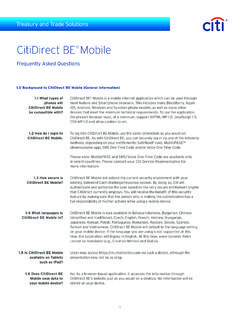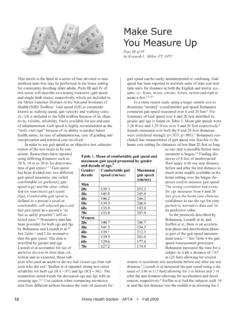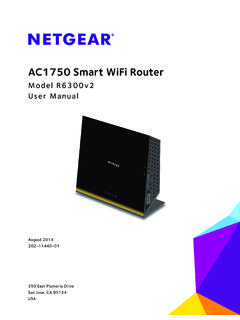Transcription of RMS Technical Requirements for Crime Analysis - …
1 IACA Standards, Methods, and Technology Committee, Technology Chair: Matthew Harris, Crime Analyst, Sonoma County Sheriff's Office IACA Standards, Methods, and Technology Committee Chair: Jason Elder IACA SMT Technology Subcommittee Technology Member: Bryan Hill, Crime Analyst, Glendale Police Department Travis Taniguchi , Senior Research Associate, Police Foundation Subject Matter Experts: Stacy Belledin, Crime Analyst II, Lakewood Police Department Tony Berger, Detective Sergeant, Pierce County Sheriff's Department Rita De Lucchi, Crime Analyst, Berkeley Police Department Heather Lane, Crime and Intelligence Analyst, Mansfield Police Department Abigail Luczon, Sr. Crime Analyst, Glendale Police Department Jim Mallard, Crime Analyst, Winter Park Police Department Editors: Todd Wiles, Crime Analyst Project Coordinator, Cleveland Police Department Erika Wiles, Crime Analyst II, Akron Police Department Suggested Citation: International Association of Crime Analysts.
2 (2013). RMS Technical Requirements of Crime Analysis (White Paper 2013-01). Overland Park, KS: Author. International Association of Crime Analysts (IACA) RMS Technical Requirements for Crime Analysis Standards, Methods, & Technology (SMT) Committee White Paper 2013-01 August 2013 1 About the IACA Standards, Methods, and Technology Committee Through the Standards, Methods, and Technology Committee (SMT), the International Association of Crime Analysts (IACA) is committed to a continuing process of professionalization through standards and knowledge development. In 2011, the IACA chartered the SMT Committee for the purpose of defining analytical methodologies, technologies, and core concepts relevant to the profession of Crime Analysis . 1 This document is part of a series of white papers produced by the SMT committee that accomplishes this purpose.
3 The methodology for formulating the positions reflected in the white paper series includes: 1) development of a draft paper through in-depth meetings and discussions of Subject Matter Experts,2 2) review and feedback by the IACA Executive Board, 3) review and feedback from an independent editor with knowledge of Crime Analysis , and 4) review and feedback by IACA members facilitated through the IACA website ( ). Questions about this process should be directed to the chair of the SMT Committee at Overview This document has been prepared by the IACA SMT Committee to address the Requirements of records management systems (RMS) as used by law enforcement agencies for Crime Analysis . A RMS is an agency-wide system that provides for the storage, retrieval, retention, manipulation, archiving, and viewing of records, documents, or files pertaining to law enforcement The primary intended use of this paper is to provide Crime analysts, administrators, and other key decision-makers with fundamental RMS Requirements for successful Crime Analysis .
4 This document explains some of the key applications and functionality needed to support and facilitate sophisticated Crime Analysis . There are recommendations throughout the paper with regard to workflow within the agency, questions to ask vendors and information technology (IT) personnel, and key things to consider when upgrading or replacing a RMS. At the end of this paper is a list of relevant literature covering these topics in detail; throughout, there are footnotes that point directly to key readings. A checklist that can be used to evaluate RMS packages from a Crime Analysis perspective can be found in Appendix A. Principles discussed in this document also apply to other systems such as online citizen Crime reporting, jail management, traffic citation/collision reporting, and mobile applications for tablets or phones. Analyst involvement in procurement and implementation Crime Analysis units are typically responsible for retrieving data from the RMS for the purpose of reports, Analysis , and investigation; therefore, analysts often have valuable input as to how this data should be collected and stored.
5 Analysts use this data in administrative and strategic Analysis to lay the quantitative foundation for problem-oriented projects and intelligence-led initiatives. This data is crucial during tactical Analysis to identify patterns and trends, and to support investigations by researching people, places, and properties. Poor data entry and lack of proper data flow can hinder investigations and analytical data retrieval. These problems can be mitigated by having analysts involved at the earliest stages of procurement. 1 Drawn from the mission statement of the Standards, Methods, and Technology Strategic Plan (April 2011). 2 Subject Matter Experts are identified by the Standards, Methods, and Technology Committee based on their special knowledge demonstrated through publications, presentations, and practical experience and their willingness to participate.
6 3 See, generally, IACP/COPS Technology Assistance Program (2004). 2 During the procurement phase, analysts can assist decision-makers by assessing each vendor to ensure that the selected system meets the agency s current and anticipated needs. In addition to the items covered in appendix A, analysts should develop a checklist or consistent and objective set of questions to ask of all software vendors. Examples include: 1) Does the RMS have complex data validation rules that increase data accuracy and quality without complicating the data entry process? 2) When performing data entry, are the steps for selecting existing master records (names, addresses, vehicles, property) simple and straightforward yet fail-proof? 3) Is the system built with open architecture that allows users to view and query against data and documents using third-party search tools?
7 4) Does the system store geographic coordinate information regarding calls for service, incidents, traffic collisions, contacts with people and vehicles, and property? 5) Are the coordinates stored in an easily useable format? Some vendors store coordinates in a single field that must be parsed, while other vendors use coordinates that have to be divided by 100 before they can be used outside the RMS. 6) Does the system allow for re-geocoding of data if the agency receives updated reference files (centerlines, parcel files, etc.)? 7) Can the RMS provide answers to agency-specific questions in a way that is acceptable? Generally, analysts have a unique insight regarding questions that law enforcement personnel need answered. Does the RMS provide solutions to these problems? Analysts can also help to ensure the proper setup of the RMS by verifying look-up tables, required fields, mapping infrastructure and automated reports.
8 Taking time to thoroughly review the data configuration in advance will save time in cleaning data, geocoding, and producing reports, leaving more time for investigations and Analysis in the future. Recommendation 1: Analyst Involvement in Procurement and Implementation. The Crime analyst should be involved with the procurement and implementation process, especially when connecting to and setting up the RMS mapping infrastructure, building and modifying look-up tables, and determining required fields. Data Management The primary purpose of the RMS is to collect and store Crime -related data. The best systems have efficient processes for entering, storing, and retrieving data while at the same time maintaining data quality. Systems that collect and store this data in an efficient and accurate manner drastically improve analytical capabilities.
9 Good systems also store the data in a way that is accessible outside of the system in an easily comprehensible structure. The RMS is one of the main sources that Crime analysts use to monitor and analyze Crime within their jurisdictions; therefore, they must have a firm grasp on how and where the data is stored within the RMS. Open Architecture Analysts often use third-party tools that utilize information in the RMS through a database connection. Examples of these tools include geographic information systems (GIS), link Analysis tools, reporting and statistical software. 3 The RMS should be designed with an open architecture, meaning that the records are accessible to third-party software packages. It is crucial to avoid systems that store information in proprietary file types or inaccessible locations. Although systems usually provide built-in reporting functionality, these reports frequently fall short of meeting the needs of most agencies.
10 Data should be available via standardized database connectivity protocols such as Open Database Connectivity (ODBC),4 Object Linking and Embedding Database (OLE DB),5 Java Database Connectivity (JDBC),6 etc. If third-party tools will be used to search or report on RMS data, analysts should question whether the data types in the RMS support their needs. For example, images stored in a database field as file path references are easier to report on than images stored in binary field types. Binary large object (BLOB) field types should be avoided unless absolutely necessary and not used to store images or large unstructured Unstructured text elements (such as narratives) are easier to display and filter when stored in text-based fields. Analysts must be able to ask specific questions to determine if the vendor s database structure supports the tools at their agencies disposal.










